Graphology Basics
What is Graphology? Graphology is a technique that allows us to become knowledgeable of ourselves and also explore those who surround us. Through the study of letters called graphological analysis, it is possible to study patterns of writing that identify the psychological state of a person and to evaluate the characteristics of their personality. It is an economical method, fast and exact.
It is applied as a complementary graphical projective technique of psychology in order to detect slight or profound conflicts and to contribute to diagnosis and follow up. It is also applicable to other areas such as medicine, psychiatry, law, criminology, education and personnel selection in companies.
Graphology Basics: Tools and Writings to Analyze
What kind of writings and tools are necessary for graphological analysis?
- A spontaneous text as large and complete as possible shall be required (a letter longer that a single page, dated and signed, directed to someone of trust).
- Present and previous writings shall be required.
- White, plain paper, without lines nor grids.
- Paper size used is A4.
- The pen must be the one that the individual uses regularly. If the person does not have a preference, a normal tip point is offered.
It is not recommended:
- To perform graphological analysis on notes, copied text, photocopies.
- To interpret an isolated trait.
- To establish a clinical diagnosis.
First Steps: Anatomy of Handwriting
In order to understand how this technique called graphology works, we must know the Anatomy of Handwriting.
Graphology Basics: Which are the parts of a letter?
In order to study graphisms, the following parts of a letter have been identified:
- Strokes are the path made by the writer in a single impulse.
- Down strokes are the thick strokes going downwards, descending on letters.
- Up strokes are the thin strokes going upwards, forming letters.
- Ovals are the central or middle area of writing. They are described as the “eyes” of letters a, g, o, q, d, etc.
- Upper extensions are the full strokes of the superior area of letters b, d, f, h, j, l, ll and t up to the middle area; also are considered upper extensions the vertical lines of letters n and m, capital and lowercase.
- Lower extensions are the strokes going downwards going from the middle area up to the lower end of letters f, g, j, p, q, y and z.
All letters have an essential area and a secondary one.
- Essential stroke: It is the unexpendable part of the structure, the skeleton that grants identity to the letter without which it cannot be identified.
- Accessory or secondary part: Is the unnecessary added trait that is not essential to the form of the letter. It is the “decoration” or ornament that may not appear.
Loops: Are “eyes” that are formed by the intersection of profiles and crests.
In letters we also identify different areas:
Five Zones of Writing
- Starting stroke – Initial area: Is the section where the letter begins.
- End stroke – Final area: Is the section where the letter ends.
- Upper zone – Superior area: Is the highest point of letters, is occupied by crests, dots, accent marks, the bars of letter “t” and the upper areas of capital letters. Ascending letters are b, d, h, k, l, ll, t, f and part of capital letters.
- Lower zone – Inferior area: Is represented by feet and descending areas of some capital and lowercase letters. The descending letters are: g, j, p, q, y, z and f.
- Middle zone – Middle area (or central area): Is occupied by all lowercase vowels and other letters that have no extensions m, n, r, c, ñ, s, v, w, and x, it represents our ego. When three zones are of equal size, the writer is well balanced. Only letter f spans the three zones.
How are these areas interpreted?
Each one of these zones of writing corresponds to a meaning associated to graphic symbology of space. When analyzing a text we shall observe whether the writing is aligned to the right, due to a large left margin or little right margin, or to the left. When aligned to the right, it will reflect an advance to the future, towards others, a person with initiatives, and predominance of extroversion.
On the other hand, if the text is placed to the left (due to a large right margin) it will give us an idea of a person holding on to the mother’s womb, to the family of origin, to the past and predominance of introversion.
When the text is placed on the center, in the middle area, may be a sign of egocentrism and narcissism. This is confirmed along with the individual’s signature (if placed in the middle).
The highly developed superior areas (including a lot of text facing upwards) speak about idealistic, spiritual, mentally active and imaginative people. There, we will be able to investigate the reflections and dreams of the individual.
PDF The Zones of Handwriting
Click here to download the PDF: Printable The Three Zones of Handwriting
Explore the PDF pages on this website to find more resources you can add to your own Graphology book!
The strongly developed inferior areas refer to people that are sensual, practical, realistic, worried about the care of their own bodies and who look for satisfying their immediate needs. Absolutely everything on a text is coated with symbolism of space, from the relationship between written and empty spaces to the description of letters each one individually. According to graphic symbolism of space, conduct is reflected in writing.
When writing areas are in equilibrium and none stands over another, means that this person is able to control their impulses, their state of mind and that is emotionally stable.
Starting strokes and Final strokes
The initial and final strokes represent in graphology the way an individual begins and finishes a certain action. The way they act.
The initial stroke is the one that appears at the beginning of graphic signs. These can be letters, numbers and diacritical marks. They symbolize the way the individual makes contact with his surroundings, the beginning of actions, the origin of impulses and the ongoing intentions. The initial stroke reflects the attitude of the individual towards their desires, needs and is linked to memories, experiences and affective experiences of the past of the writer.
In the final stroke we can find more subconscious material than in the initial stroke due to the fact that it appears at the end of the writing where there is less control.
Read also: What can signature analysis reveal?
Letters and their Movements
From the point of view of movement in execution, the graphic impulse may take four different directions called vectors: up, down, right and left.
- Ascending movement or up-strokes: From the movement of extension, profiles turn out.
- Descending movement or down-strokes: From the up-down or flection of the forearm, hand and fingers, fulls turn out.
- From left to right or hand or finger abduction, dextrogyrous strokes turn out.
- From right to left or hand or finger adduction, sinistrogyrous (or levogyrous)
Important for Basic Graphology
- Flection and adduction movements express centripetal direction towards the EGO.
- Extension or abduction in centrifuge direction go towards the outside (from me towards you).
- Movements going upwards or the superior area are allocentric.
- Movements going downwards or the inferior area are egocentric.
These movements can be:
- Linear, which are the ones that do not present torsions or deviations in the stroke.
- Curve, which are the ones that are circled or oval (like in letters a and o). Out of curve movements, the following derive: the garland, ae arch, curl, lace, serpentine or wavy movement and the spiral.
- Angled, which are the ones formed by straight lines that cross each other or break. Out of the angled movements, the following derive: the mace, the triangle, the harpoon, the sabre hit, the whip hit and the shake-off.
In order to carry out a graphological study, the eight graphical categories that reveal the writer’s personality are studied. Each one of them reflect in the psychological aspect, different levels of the personality:
- Layout/ Order: (Along with the following sub-aspects: Distribution, disposition and proportion) It indicates capacity of organization and adaptation.
- Dimension of writing: Self-esteem, need for expansion of tendencies, energy and impulses.
- Form: It indicates cultural level and manners.
- Speed of writing: Level of intelligence.
- Pressure: Energy and productivity.
- Direction lines: Variation in state of mind and humor.
- Slant: Need for contact with others.
- Connection forms: Type of intelligence, intuition. Capacity for conjugating ideas.
The psychological interpretations thrown out by each one of them may be contradictory and ambivalent. In order to recognize which of the interpretations corresponds to each one, it is important to determine whether the graphical environment of the text is positive or negative.
What is the graphical environment of a writing?
The graphical environment is the global appreciation of a writing. It is the first impression of the whole. People are ambivalent beings by nature, moving between opposites. Good-bad, health-illness, yes-no, I want-I do not want, self-control-impulsiveness. Our tendency to find the equilibrium in this dual world is also reflected in writing. There is the challenge of finding out the right meaning.
The graphical environment is positive when graphical aspects are in harmony. The graphical environment is negative when there is unevenness, crossing-outs, among others.
Handwriting and Graphology Basics
The object of study of graphology is handwriting. The act of writing is a complex one that involves three different mental processes. The visual, through eye-sight, the motor, through fine motor skills that are required to move the pen over the sheet of paper and the cognitive-perceptive process that makes thinking flow from the mind to the written words. Writing is used with the purpose of communicating, expressing and is the graphical record of the conscious content (intentional) and subconscious (latent) of the writer.
Writing is not genetic. It needs to be transmitted. Sumerians created cuneiform writing in old Mesopotamia on clay boards. From there, the human brain has generated a wonderful network of processes of association of the visual areas with those representations that contribute with information to the meaning process.
Advantages of Handwriting over the Keyboard
The neurowriting system is a complex and multicomponent system that involves the activation of several brain areas. The fact of using handwriting forces the brain to use all brain areas. It is an act of specialization and coordination of both hemispheres. The brain hemispheres are composed by four lobes:
- Frontal lobe: Located in the front section. That is where sequences of ideas are created, where thoughts are elaborated and the written content is planned.
- Parietal lobe: Located on the sides of the superior section of the brain. It performs sensory functions and coordinates eye-hand sequences.
- Temporal lobe: Located on the sides, behind the ears. That is where the hearing center is found. Compresses the spoken word, discriminating each sound and identifying each letter, graphic and phonological function.
- Occipital lobe: Located in the rear section of the head. It is associated with the visual area and it identifies written words.
The act of handwriting activates all of these brain areas. They are activated electrically and chemically through neuronal connections, forming language, thinking, memory and intelligence. Training of handwriting stimulates intelligence, since the brain has to “work” a lot more than when using the keyboard.
Graphology Basics: We do not always handwrite the same way
Through graphology we observe that graphisms change and that we do not always have the same handwriting. This is due to the fact that the nervous system is dynamic and that handwriting is the reflection of our brain. Advantages over the usage of a keyboard are:
- Through handwriting we acquire fluency of ideas.
- Reading skills improve.
- Memory is developed.
- It stimulates a better knowledge of grammar rules.

Read also: Graphology: Handwriting Analysis Strokes.
Keep navigating this website to continue discovering the Meaning of margins and Resilience in handwriting.

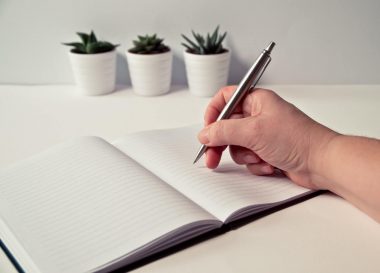


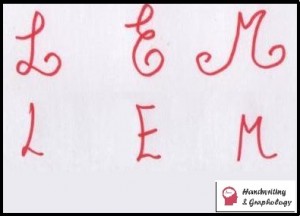
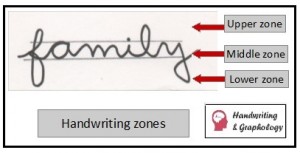
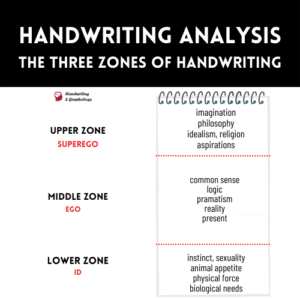
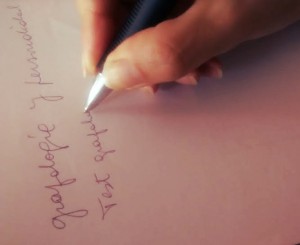



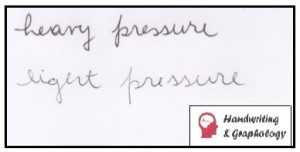
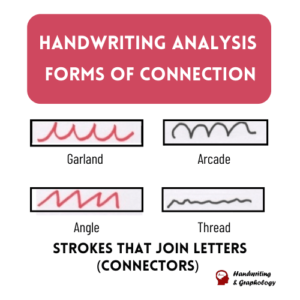


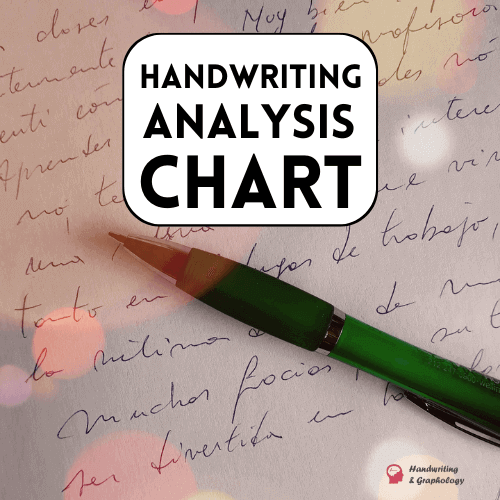
Great to get idea about graphology. Really helpful.
I am very interested in this study and am glad you have opened it up to all of us who are. I am going to share this page with my husband and mom. Thank you
Superb I really very happy to know these all things.
excelent
I’m a graphology hobbyist. I have often used handwriting analysts to assess employee candidates before hiring. This article is clear and well-writtenThe illustration #s 20, 21, 22, 26, 27, and 28 are missing. Your proofreader probably neglects to cross his/her T’s sometimes.
; /
Hi, can I get an analysis of an actual letter done?
What about writing a number 8?
Some people write number from Bottom-to-Top and some from Top-to-Bottom.
I always loved to write personal notes in my career. Often 3-4 weekly. I was right handed but had cancer at age 70 and lost the use of my fine motor skills on the right side. I taught myself to write left handed. My brother thinks my left handed writing is even better than my right handed writing before cancer. Is there any science or history that talks about changing hands later in life. I am now 83. If so, let me know.